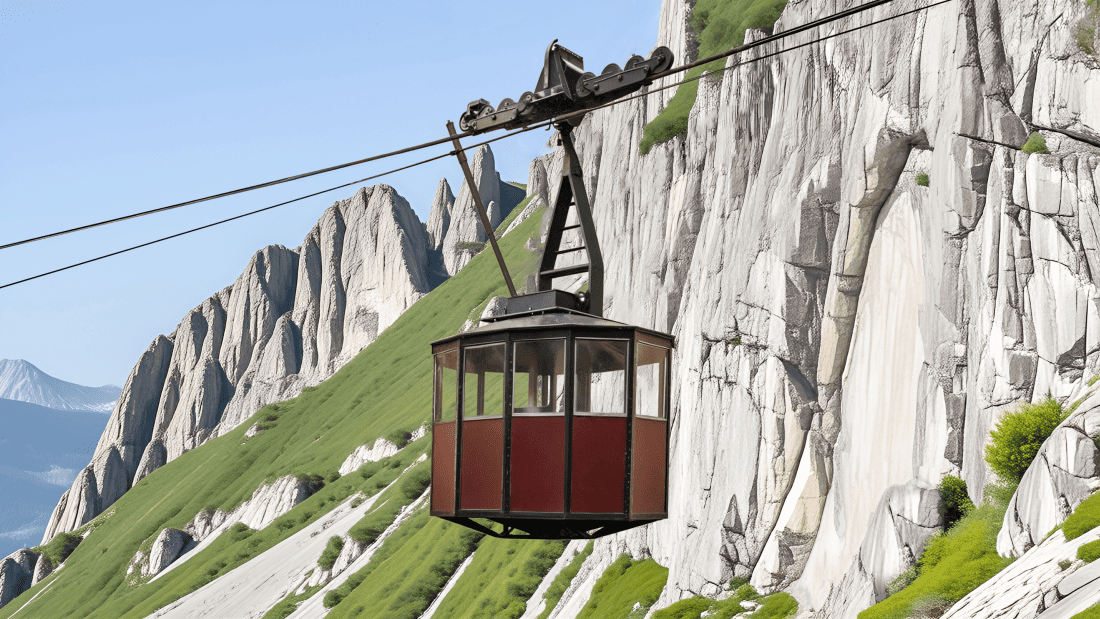Cable car systems that cost thruppence each? Yes that is what this post is all about! On a far more serious note, the thruppenny was what many called the old British three penny – and that because it was a twelve sided dodecagon shaped coin. Hence a number of cable car systems featuring dodecagon shaped cabins (twelve sides too) emerged in the early days of the world’s cableways. Why the cabins were twelve sided isn’t known but in any event they were not circular but oval shaped. These ‘thruppence’ cable cars had the very latest innovations and set the scene for how cable car cabins ought to be built. They were all built by the same company – Bleichert’s. Finding information and/or images proved to be very problematic for some of the systems featured which were obscure or long forgotten. This is perhaps the first blog post ever written with a focus purely on these uniquely shaped cable cars – as opposed to coverage of the Bleichert built systems in general.
The Bleichert cabin patent (1928).
The cable cars are shown in chronological order – and its just 17 that were built as dodecagon shaped cabin systems by Bleichert of Lepizig. Hopefully that’s every single one of these threepenny cable car systems listed and none have been missed off!
Predigtstuhlbahn (1928)
Opened 1st July 1928. A unique system that is approaching its 100th anniversary of operation. The Predigtstuhlbahn is located at Bad Reichenhall in Bavaria. Its the oldest surviving cable car in the world and is affectionately known as the “Grande Dame of the Alps.”

Bleichert-Juegg diagram of the sections between the pylons on the Predigtstuhlbahn. Wikipedia.

Predigtstuhlbahn poster 1930s. Invaluable.

View looking down the cableway towards Bad Reichenhall. Wikipedia.

The bergstation. Wikipedia.
Wankbahn (1929)
Opened 4th May 1929. Its original Bleichert gondolas were replaced in 1960. There’s no doubt this is a cable car system with a name that might seem curious to the English user. Invariably its what the mountain is called and the term alludes to an old German word for slope. Even so, the ‘w’ is replaced with a ‘v’ thus its pronounced the Vankbahn.

One of the gondolas on the Wankbahn in 1960. This was the last year of their use on the cableway. Zugspitzbahn.
The former Garmisch-Partenkirchen cableway was replaced by a modern gondola system in 1982. The Bayerische Zugspitzbahn and the town’s council wanted to advertise the village and its cableway at the recent Skiing World Cup in January 2025 however the International Ski and Snowboard Federation imposed a ban on the name for fear of upsetting English users. Daily Mail.
Burgbergseilbahn
One of the four original cableways still in operation. Opened 17th July 1929 and located in the Harz Mountains of Germany – where the famous Harz Railway is also to be found. Located in Bad Harzburg, the Burgbergseilbahn is the oldest cable car in Northern Germany. Slightly spoilt in its historical look by way of the original cabins being replaced by somewhat similar designs in 1969.

The Burgbergseilbahn. Wikipedia.
Aeri Montserrat (1930)
Opened 17th May 1930 and the third oldest surviving cable car following the Predigtstuhl and Burgberg seilbahns. Montserrat is located in Catalonia and is noted for the monastery. The mountain has a variety of transport including buses, rack railways and funiculars. Once there were two cableways however the other (Aeri de Sant Geroni) shut in 1983. There’s a new mountain railway which replaced an older line.
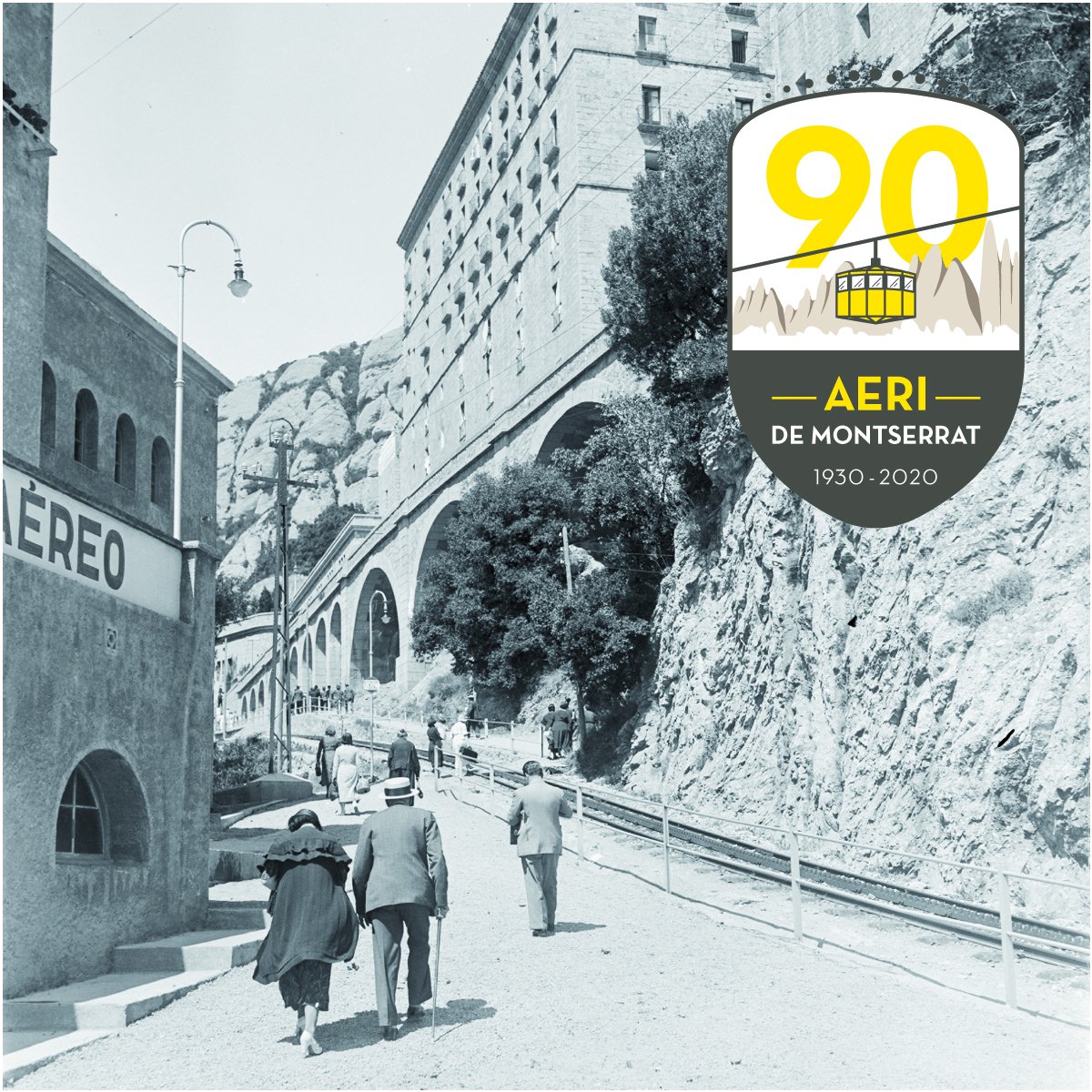
Picture released for the 90th anniversary of the Aeri showing passengers leaving the upper cable car terminus (at left) and about to walk alongside the older steam rack railway. The 2003 line uses the same alignment. Source: Twitter/X.

The Aeri in its early days with a cabin near the upper of the line’s two concrete pylons. El Tranvia.
One unique aspect of the Aeri is the base station is served by a lofty cantilever river bridge (known as the Pont de l’Aeri de Montserrat) that was built solely for the purpose of accessing the cable car. Thus one can be passing across the deep Llobregat gorge this bridge spans, and then a short time after, having parked their car or alighted from their coach, be passing over both the bridge and its gorge as their cable car ascends to Montserrat!

The Llobregat River bridge with a cable car descending towards its base terminus. Wikipedia.
Zugspitzbahn (1931)
Opened 26th January 1931. Bleichert cableway from near Garmisch-Partenkirchen to the summit of Germany’s highest mountain. The system included the Zugspitze railway thus visitors used both rack railway and cable car to reach the summit, completing their journey by this particular cable car. The whole system is now considerably altered with a cableway from Eibsee opened in 1963. The Bleichert cable car was replaced by the Gletscherbahn serving the railway’s new terminus from 1992 onward.
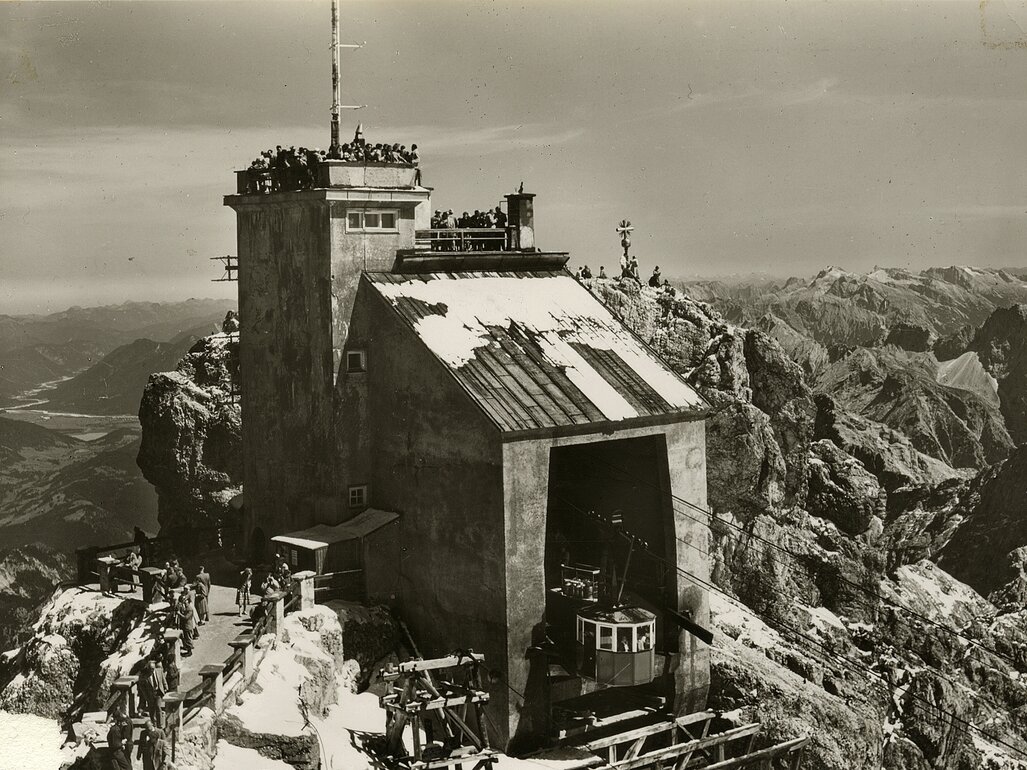
Zugspitze Kulm with one of the twelve sided Bleichert gondolas present. Zugspitzbahn.
Aeri del Port (1931)
The Aeri del Port (or Port Vell Aerial Tramway) is sited in Catalonia and was opened on 12th September 1931 as part of the 1929 Barcelona International Exposition. Its the fourth oldest surviving cable car in the world. The system begins in Barceloneta at the San Sebastián tower and rides high above the city’s docks to the Miramar terminus on Montjuïc.
The aeri employs one base station (containing the machinery) and two tall steel towers. There are spectacular views of the city. Basically one gets a trip up a tower, a cable car ride across the docks passing through another tower before reaching Miramar. There are spectacular city views plus hills and mountains in the distance.
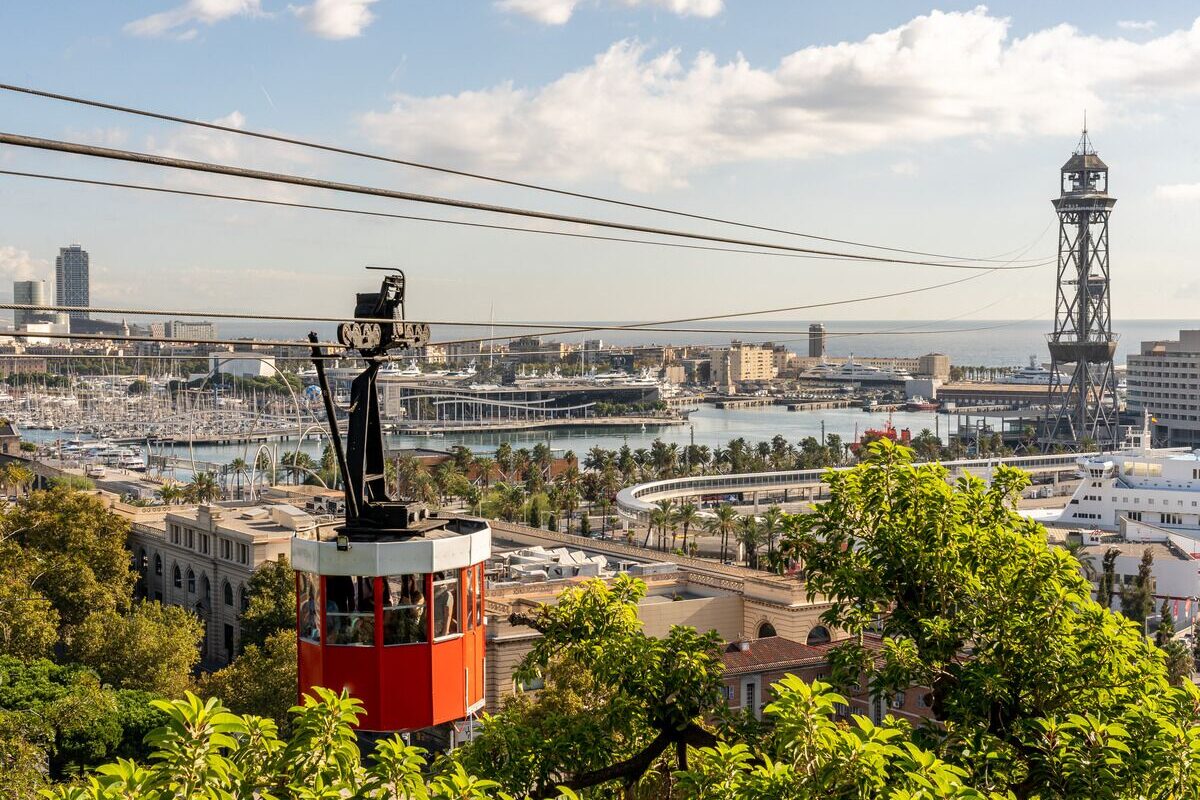
The Aeri del Port looking from Miramar towards the docks and the Jaume I tower. Spain Voyages.
Originally the system consisted of two separate sections linked by the Jaume I tower where passengers had to switch cars. A redesign now means Aeri del Port cars cover the entire journey without a change.
Funivia Sestriere-Alpette-Sises (1931)
Sestriere in northern Italy amazingly had three cableways, each of those with iconic dodecagon shaped cabins designed by Bleichert – for which a patent was registered. Thus no other company could use that design and its why these thruppenny shaped cabins remain unique to Bleichert. Not a lot is known about this nor the other lines to Monte Banchetta and Monte Fraiteve.
The line from Sestriere to Alpette and Sises opened on 17th January 1932. This and the other two Bleichert lines were closed in 1986. Due to the arrangement of the three Sestriere routes, six cabins were used for four lines. That was achieved by way of having the Sises route operated by a single cabin on both its lower and upper sections. Quite why this was employed isn’t known as the mountain topology doesn’t demand this. Its not the only example of a system where a lower and an upper section are operated simultaneously.
The original lower station had been a stand alone structure upon the line’s opening in 1932. However very soon after it was incorporated within a newer and larger development being built at Sestriere. In the event only the frontage of the building remained (the bit from which the cable car emerges).

Sestriere as it was originally in the 1930s with its circular towers and the two cable car stations incorporated into the development. The view is taken from the line to Sises whilst the station for Monte Banchetta can be seen at extreme right. The other route to Monte Fraiteve can be seen behind with its pylons ascending the mountain. Papergreat.
The modernist development that rose up about the cable stations was built by Giovanni Agnelli, President of Fiat, with the help of others including Vittorio Bonadè Bottino and Carlo Mollino. In 1934 Sestriere was designated a town.
The two towers, designed by Vittorio Bonadè Bottino, symbolised the town of Sestriere and their history can be read here. In the older days the area that is now Piazza Agnelli (behind the cable car terminals) was once known as Piazzale Funivie – otherwise Cable Car Square.
The Sestriere-Alpette-Sises line consisted of just two cabins – each on a single route with the machinery at Sestriere operating both lines. The arrangement was complex nevertheless both lines operated simultaneously and the cars met at Alpette where passengers simply crossed to the other in order to complete their travel to either Sestriere or Sises .

The Sestriere-Alpette-Sises system. Vialattea.
The original cable car stations at Sestriere are no longer extant. The Alpette-Sises line was once to be found here as seen on Google Streets. In that view the same exact buildings as shown above can be recognised – minus the cable car terminus. This is the same for the next system – that to Monte Banchetta whose former lower terminus was once sited here at the other end of the development – as seen on Google Streets. The upper terminus at Sises however remains in a derelict state as the picture below shows, and there’s a good Youtube video of the building.
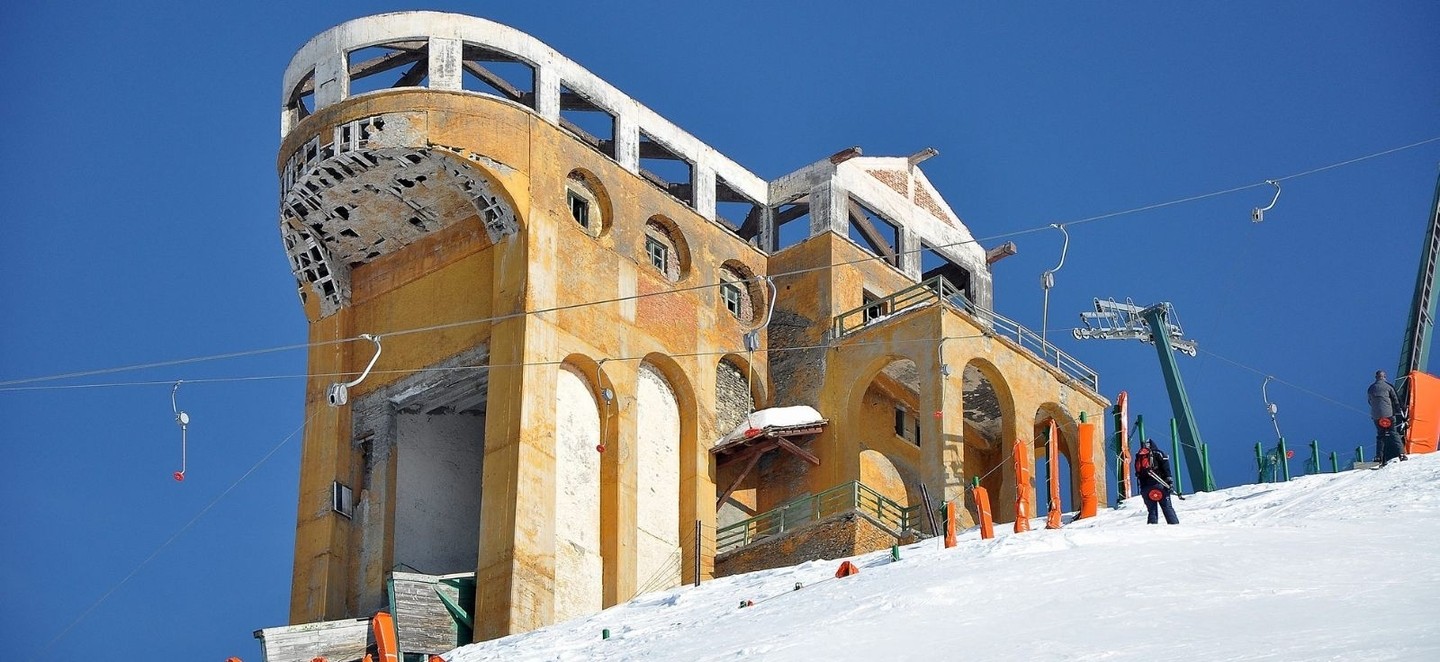
The original 1931 upper station at Sises. Dovesciare.
Funivia Sestriere – Monte Banchetta (1933)
Opened 15th December 1933. Closed 1986. So little is known about this route. Finding images proved difficult but two were sourced from Ebay.
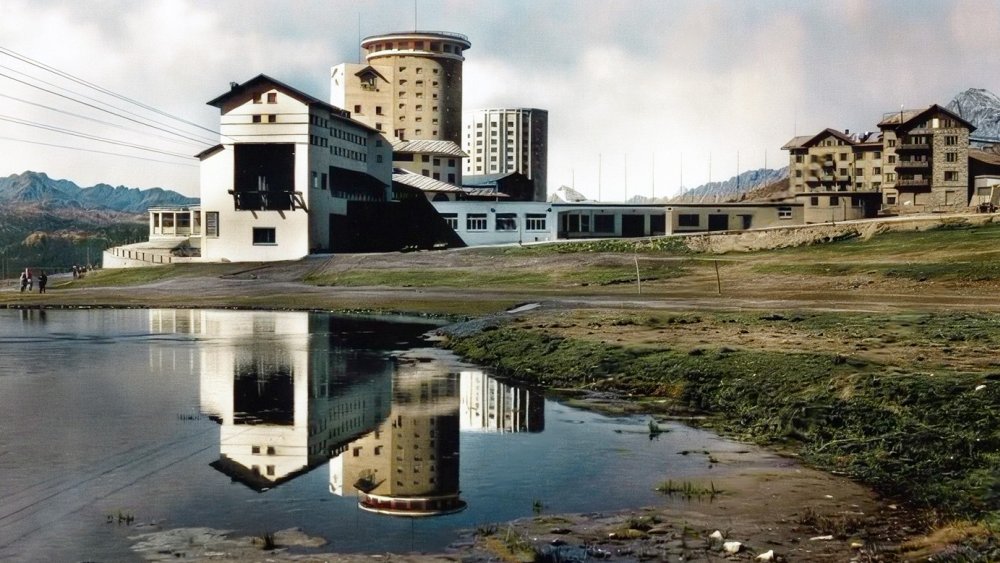
The Monte Banchetta terminal at Sestriere. Image sourced from Ebay and colourised by the author.

The cable car to Mont Banchetta 1933. Image sourced from Ebay, cleaned up and colourised by the author.
Téléphérique Grenoble-Bastille (1934)
Opened 29th September 1934, this had dodecagon shaped cars built by Bleichert’s. These examples didn’t last very long however and were replaced in 1956.
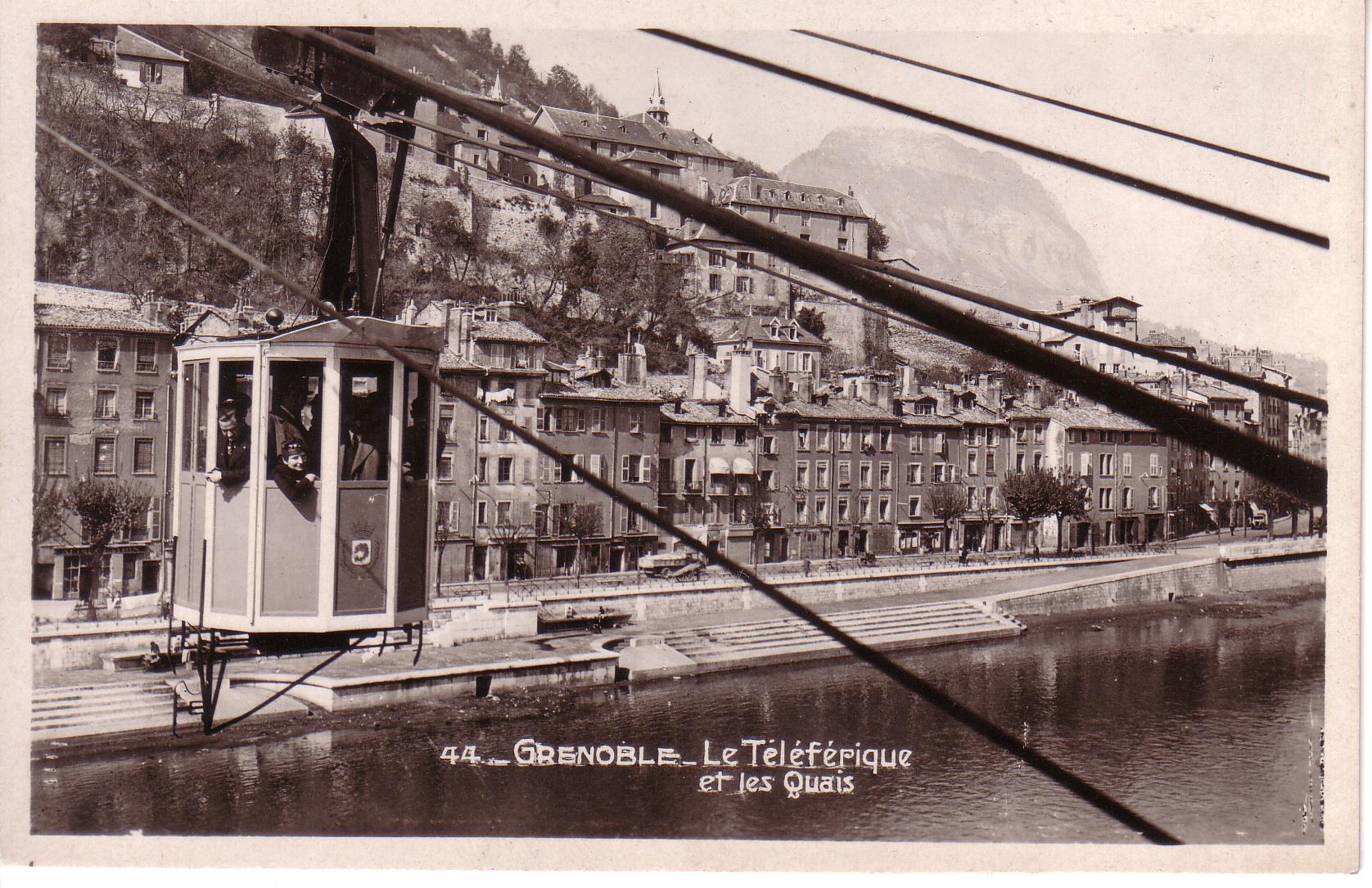
The original threepenny shaped cabins on the Grenoble system. Téléphérique Grenoble-Bastille.
Téléphérique Du Mont D’Arbois (1934)
Opened 23rd December 1934. The system, located at Megève on the west side of Mont Blanc, was built by Baron de Rothschild. The original cabins were replaced in 1956. A gondola system was substituted in 1985.
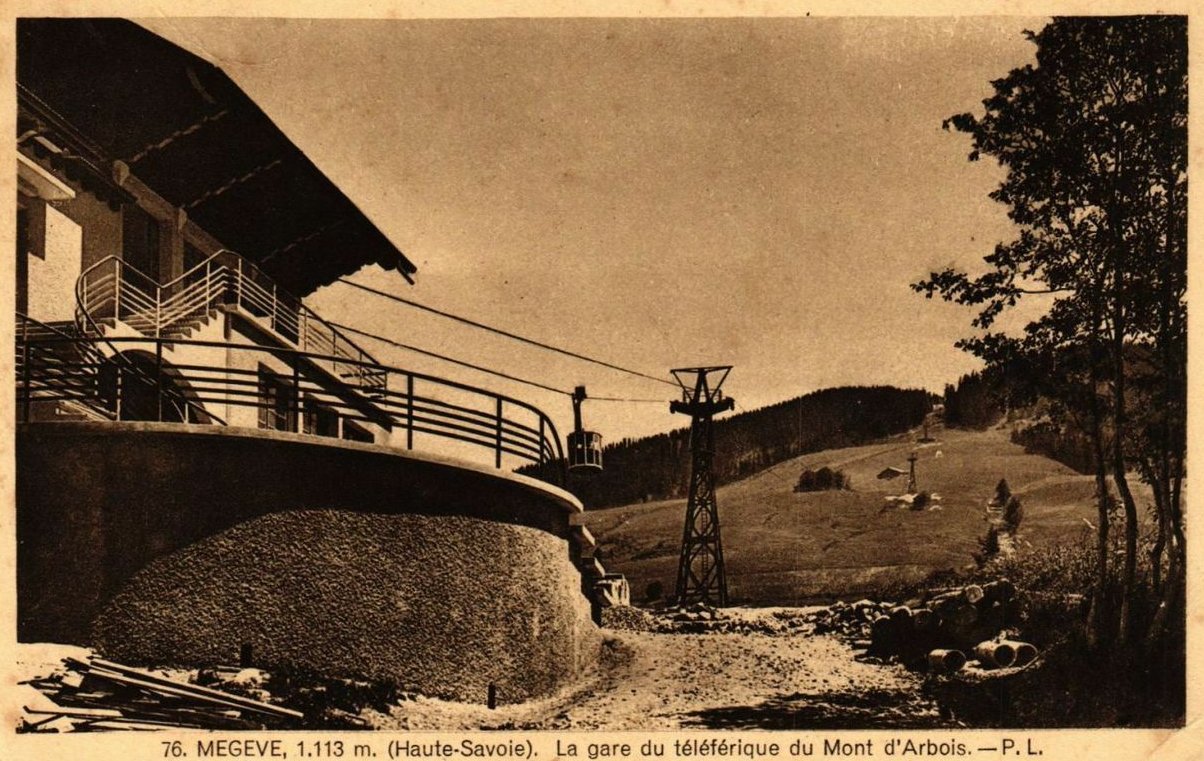
The cable car to D’Arbois. Cartorum.
Säntisbahn (1935)
Opened 31st July 1935, this seems to be the only example of a Bleichert dodecagon cabin in Switzerland. Bleichert built several other lines in Switzerland however these had traditional style cabins.
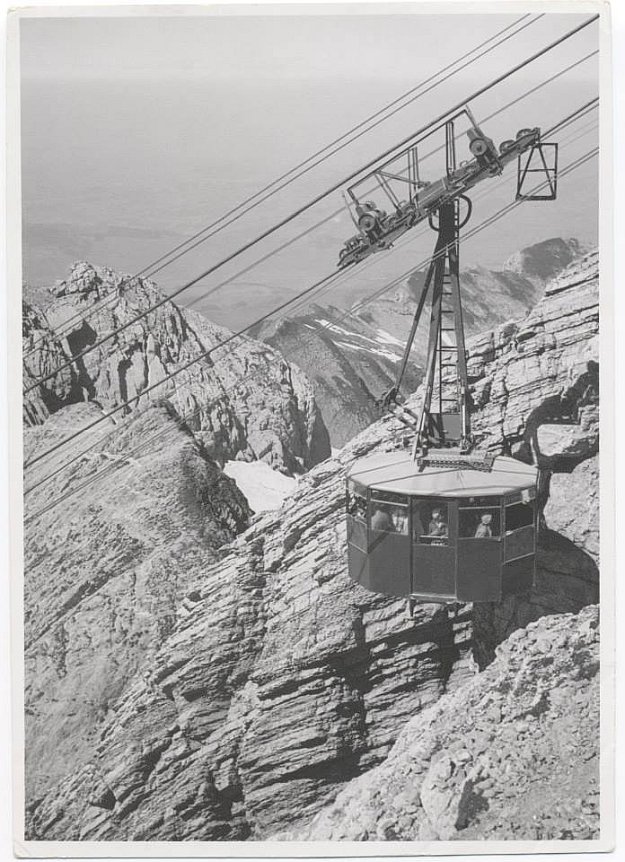
The Bleichert built Säntisbahn as seen in 1935. Facebook.
The system is located in Schwägalp and is operated by the Säntis-Schwebebahn AG (eg Säntis Hanging Railway Corporation). The original Säntis system was replaced in 1960. The 1935 built Bergstation (upper terminus) was replaced in 1972 and the system has seen further rebuilds. The Schwebebahn 2026 project will see a completely new cableway built.

The original Säntisbahn cabins. Säntisbahn.
Kolejka linowa Kasprowy Wierch (1936)
The cablecar from Kuźnice to Kasprowy Wierch in Poland was built 1935-36 and the line involves two separate stages – Kuźnice to Myślenickie Turnie and onward to Kasprowy Wierch. The mountain now has a modern cable car. There are other cable cars plus rack railways in the High Tatras – a stupendous Alpine area with lots of mountain rides in both Poland and Slovakia.

The intermediate station at Myślenickie Turnie in 1936. Publicystyka.
The upper section of the route to Kasprowy Wierch in its early days. Onet.
Téléphérique Les Houches – Bellevue (1936)
Opened 16th December 1936. Concieved by a forester from Sallanches, the system was originally intended as part of a route to the summit of France’s highest mountain, continuing via the Mont Blanc tramway – which got as far as a temporary terminus** at Nid d’Aigle before construction ceased. Both cable car and tramway pass close to each other at Bellevue.
The modern cablecars still use the original 1936 termini at both lower and upper stations. There are ongoing celebrations because the 90th anniversary of the cable car is approaching and an exhibition can be seen until 2026. This can be found at the Musée Montagnard (Mountain Museum) in Les Houches. Chamonix-Mont-Blanc.
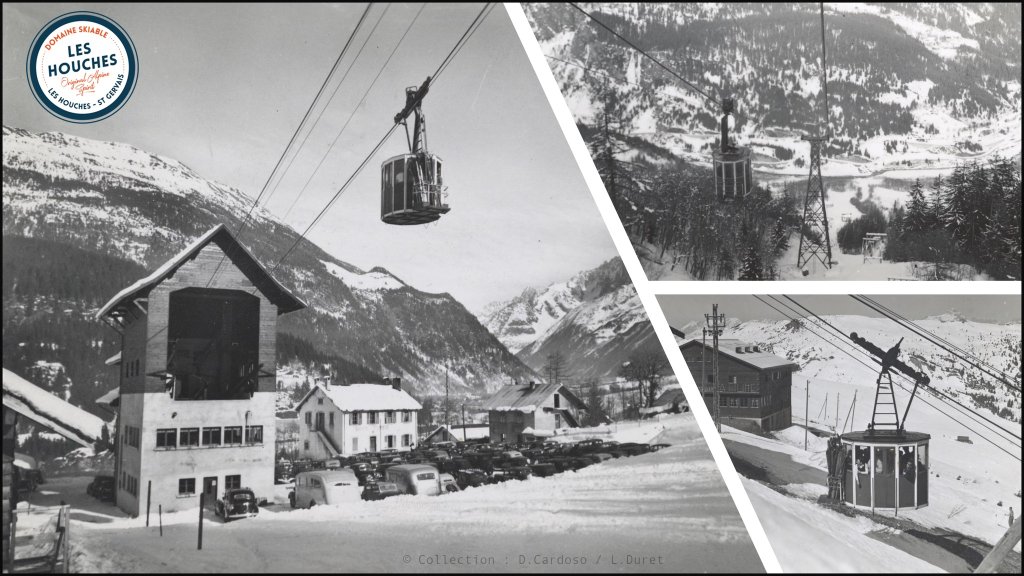
Les Houches-Bellevue cable car in its original form. Facebook.
**The Mont Blanc tramway is currently building an extension of 300 metres to the Refuge du Nid d’Aigle where a new station will be built. This will enable disabled people to properly enjoy the views from high up on the slopes of Mont Blanc. See Lyon Capitale and Youtube.
Galzigbahn (1937)
Opened 19th December 1937. Located at St. Anton am Arlberg – in the Arlberg Pass, Austria. The Galzigbahn was rebuilt with the modern Funitel gondola system developed by Doppelmayr and its sleek, modern terminus can be seen at Google Streets.
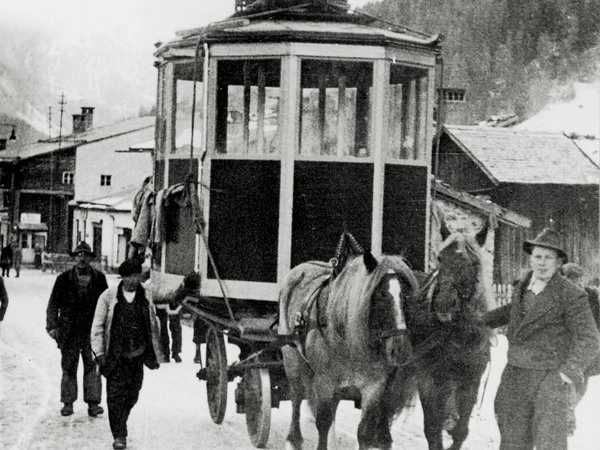
The original Bleichert cabins being taken away in 1964. Arlberger Bergbahnen.
Funivia Sestriere – Monte Fraiteve (1938)
Opened 1938 and shut in 1986. Basically nothing is known about this line apart from the dates it operated. Pictures of this Bleichert cableway are practically non-existent.
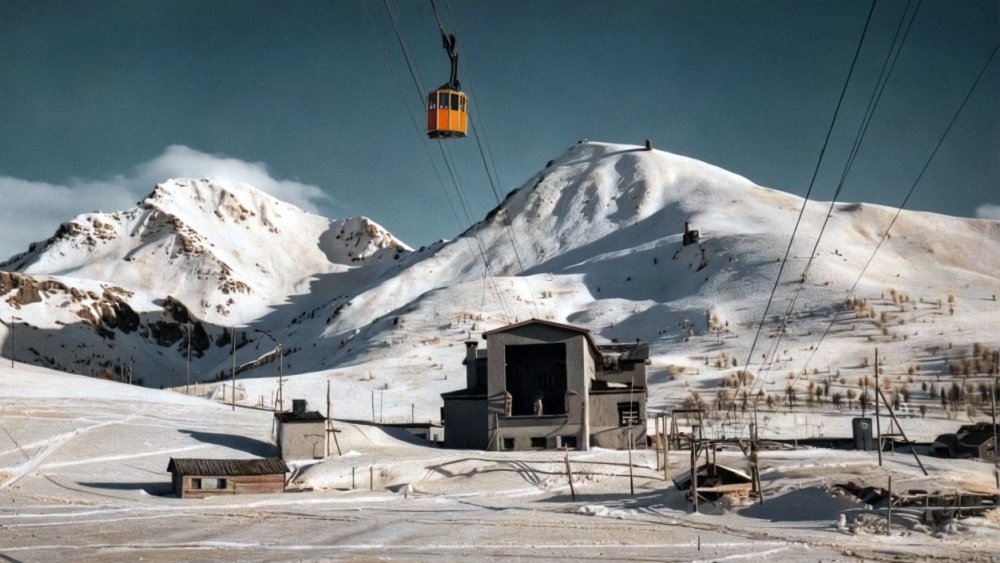
The Mont Fraiteve cable car. The cable car to Alpette and Sises can be seen on the mountain in the background. Image sourced from Ebay and colourised by the author.
Cannon Mountain Aerial Tramway (1938)
Sited at Franconia Notch in the White Mountains near to the Mount Washington Cog Railway. Most of the Bleichert systems were built in Europe however a handful of others were built elsewhere – the Table Mountain cableway being one, although its cabins like others, were non dodecagon.
Thus New Hampshire had the only Bleichert threepenny cabins outside of Europe. The American Steel & Wire Company are invariably cited in many sources as the line’s builder – however the company described itself as a Bleichert affiliate and that’s how the USA gained a cable car built by the Lepizig company.
The Cannon Mountain Aerial Tramway opened in 1938. The Bleichert system was replaced in 1981.

The system’s original Bleichert dodecagons. Cannon Mountain.
Riems Personenseilbahn (1942)
The location in question began its first cableway operations in 1927 to transit animals from the main land. However a newer and larger system was opened 1942 (and closed by either 1970 or 1972) and it featured dodecagon gondolas. At first I didn’t wish to include a cable car system that had a less than salubrious reason for its existence – this being animal experiments (vivisection). The line at Riems was the last of the thruppenny bit cable car systems to be built thus it has some importance in the history of Bleichert. A pair of cars were used either for animal or personnel transit and these were additional to an older ropeway built for the transit of animals only.
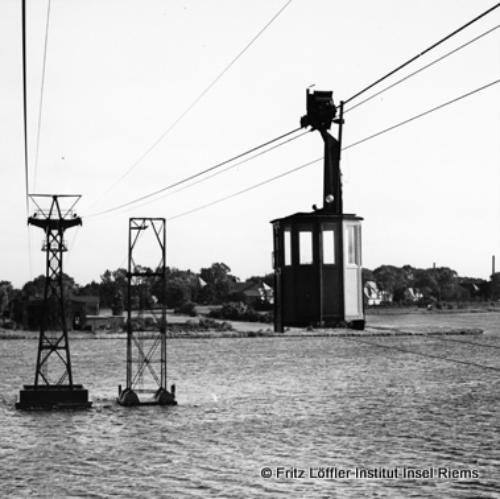
The smaller sized dodecagon gondolas on the Riems Island cableway. Bergbahngeschichte.
The Personenseilbahn served the Island of Riems in the Baltic Sea. A laboratory dedicated to the research of dangerous pathgens is located here and was once used by the Nazis to develop bioweapons. The private cableway was used for conveying both animals and people and a partition was placed in the centre of the cabins to isolate any animals needing to be sent to the island. The cableway was shut c1970 after a causeway was built to permit vehicular traffic. Riems is noted as being Germany’s Plague or Virus Island – eg Euronews.
Main feature image: Bleichert cabin set against a fake mountain scene. Image created by the author with some AI help.
